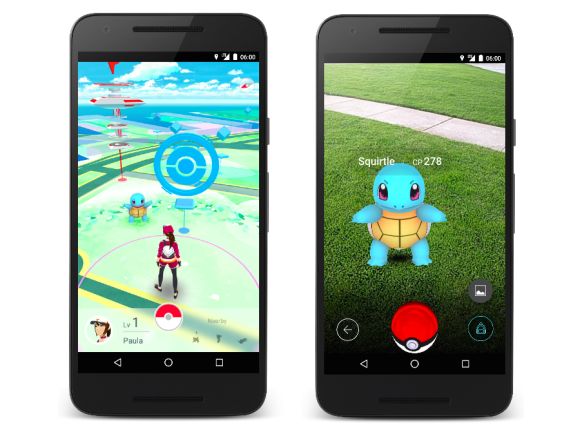
Pokemon GO has already been downloaded an estimated 7.5 million times despite only being out a week.
This is not another story about the Pokemon GO craze and the millions of people who are playing (and running into things and finding dead bodies and breaking the Internet) nor the billions it has added to Nintendo stock (is that $7.5 billion or $11 billion?). Instead we want to try and understand what, if anything, developers can use from its wild success in designing their own apps.
Mixing Virtual and Real Worlds
There has been a bit of research into how learning games that mix a kid’s real world with a digital game.
GameDesk out of Los Angeles was actually tasked by the National Science Foundation to study “kinesthetic learning” where kids interacted with games that responded to their movement – think the Wii for learning.
The research tested geoscience games that were built up from physical games that had the kids playing outside in an organized way to learn about key concepts. They tracked the development in this video:
GeoMoto – Games and Learning from GameDesk on Vimeo.
The physical play helped inform digital game development and according to a series of pre-and post-tests they conducted resulted in a game that can move the needle on student understanding of ideas like plate tectonics. In fact, their research found that scores improved anywhere from 5-25% with the games that mixed both the real and virtual world.
Other research, this time out of Carnegie Mellon, has also found there is a strong connection between the real world and real impact. But the research had a key caveat that we can see in this Pokemon GO craze – the interaction of the two worlds has to be substantive. What this research found that there was “evidence that observing physical phenomena in the context of an interactive mixed-reality game plays an important role for learning and enjoyment, while adding simple physical controls such as having the kids shake the tablet in a screen-only game or press the physical switch in a mixed-reality game does not have an effect on learning or enjoyment.”
It’s All about Exploring a World
Pokemon has always been built around the idea of collection and collections.
Whether card or console game, Pokemon was born out of the Japanese interest in bug collection and video games and how to merge the two. This new game brings that same concept to your phone and the world around you.
This is gamification at its most basic. You reward people for playing more and becoming more engaged.
As Vox wrote in their dissection of the Pokemon GO explosion, “Part of the reason Pokémon Go is popular is that it’s free, so it’s easy to download and play. But more importantly, Pokémon Go fulfills a fantasy Pokémon fans have had since the games first came out: What if Pokémon were real and inhabited our world?”
Retro Never Hurts
Although the Pokemon craze had really been in the realm of ComiCons in recent years, the characters, themes and games are going on 20 years old.
Many of the players grew up with Pikachu and Rattata and so incorporating these characters into a new mobile game has the added benefit of an established fan base or potential fan base.
A couple years ago Björn Jeffrey of Toca Boca told us how building a brand in a modern gaming world made more sense than having one breakout hit. He compared it to building a brand like Lego where once a customer knows that name the company can introduce a series of products that may find easier success in a world like the AppStore or Google Play where discoverability is so hard.
Jeffrey said that what has essentially become the Pokemon model of product development has a couple of advantages, saying, “What’s good about that is it’s good for consumers because it is an easier way to distill what’s good or not. It’s good for developers because it keeps us on our toes because if you buy something from us or from Lego that’s really bad than you are going to think twice before going back. So that means the pressure is on that every product that you make has to be as good or better than the expectations of your customers.”
Oh, And It’s Free
This is never what a developer of learning games wants to hear, but part of the reason millions are playing this game within a week of release is the cost – or lack thereof.
And so it’s pretty important to understand that the Pokemon GO effort is part of a larger reboot that is still built around a console game – Sun and Moon – set for release this fall.
Although the company has not made this an official part of their strategy, it would seem that a free mobile game may be a bit of a loss-leader for the company to build some excitement and interest in the money-maker set for this November.
Unlike other games where the mobile game IS the entire product, Pokemon is using this product as part of a much larger strategy that mixes the mobile game with other products where the real cash is.
Still, it’s in-app purchases to help track down the pesky pocket monsters is reportedly raking in millions a day.
